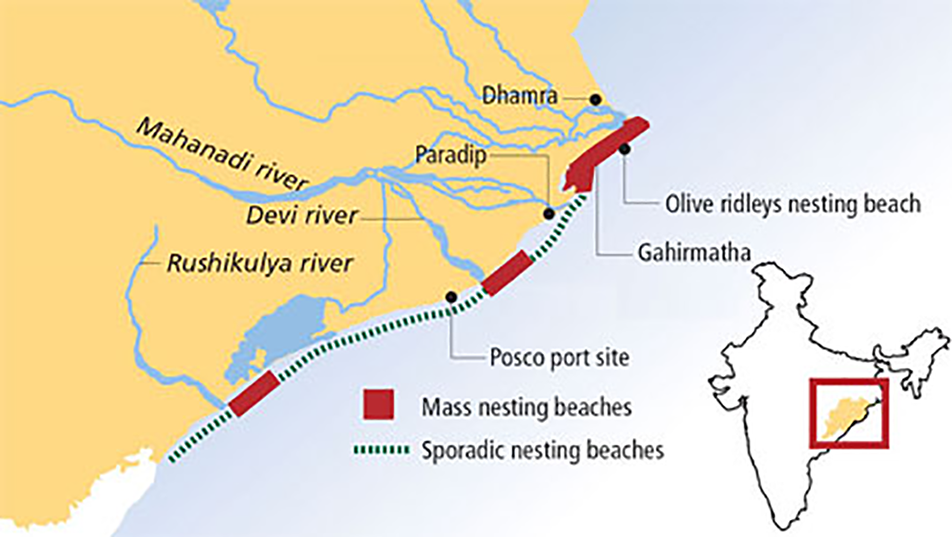Important Facts For Prelims
Olive Ridley Turtles
- 22 Nov 2022
- 4 min read
Why in News?
Pairs of Olive Ridley Sea turtles have begun emerging on the sea waters off Gahirmatha Marine Sanctuary along the Odisha coast, marking the commencement of the annual mass nesting of these endangered marine species.
What are Olive Ridley Turtles?
- About:
- The Olive ridley turtles are the smallest and most abundant of all sea turtles found in the world.
- These turtles are carnivores and get their name from their olive-coloured carapace.
- They are best known for their unique mass nesting called Arribada, where thousands of females come together on the same beach to lay eggs.
- Habitat:
- They are found in warm waters of the Pacific, Atlantic and Indian oceans.
- The Odisha’s Gahirmatha Marine Sanctuary is known as the world’s largest rookery (colony of breeding animals) of sea turtles.
- Protection Status:
- Wildlife Protection Act, 1972: Schedule 1
- IUCN Red List: Vulnerable
- CITES: Appendix I
- Threats:
- Human Consumption: They are extensively poached for their meat, shell and leather, and eggs.
- Marine Pollution and Waste: An ever-increasing debris of plastics, fishing nets, discarded nets, polythene and other garbage dumped by tourists and fishing workers threaten all sea turtles and degrades their habitats.
- Fishing Trawlers: Overexploitation of marine resources by use of trawlers often violates the rule to not fish 20 kilometers within a marine sanctuary.
- There were injury marks on many dead turtles indicating they could have been trapped under trawls or gill nets.
- Initiatives to Protect Olive Ridley Turtles:
- Operation Olivia:
- Every year, the Indian Coast Guard’s “Operation Olivia”, initiated in the early 1980s, helps protect Olive Ridley turtles as they congregate along the Odisha coast for breeding and nesting from November to December.
- It also intercepts unlawful trawling activities.
- Every year, the Indian Coast Guard’s “Operation Olivia”, initiated in the early 1980s, helps protect Olive Ridley turtles as they congregate along the Odisha coast for breeding and nesting from November to December.
- Mandatory use of Turtle Excluder Devices (TEDs):
- To reduce accidental killing in India, the Odisha government has made it mandatory for trawls to use Turtle Excluder Devices (TEDs), a net specially designed with an exit cover which allows the turtles to escape while retaining the catch.
- Tagging:
- The tagging of the endangered Olive Ridley turtles using non-corrosive metal tags is done to enable scientists to chart their movements and also know the areas they visit in order to protect the species and their habitats.
- Operation Olivia:
UPSC Civil Services Examination, Previous Year Question (PYQ)
Q. Which one of the following is the national aquatic animal of India? (2015)
(a) Saltwater crocodile
(b) Olive ridley turtle
(c) Gangetic dolphin
(d) Gharial
Ans: (c)
Exp:
- Ganges river Dolphin or Gangetic Dolphin is the National Aquatic Animal of India. The Ganges river dolphin was officially discovered in 1801. It inhabits parts of the Ganges, Meghna and Brahmaputra rivers in India, Nepal, Bhutan and Bangladesh, and the Karnaphuli River in Bangladesh.
- It is listed as endangered in IUCN Red List and has been included in the Schedule I of the Wildlife (Protection) Act, 1972.
- The main factors for decline in population of the species are poaching and habitat degradation due to declining flow, heavy siltation, construction of barrages causing physical barrier for this migratory species.
- Therefore, option C is the correct answer.





